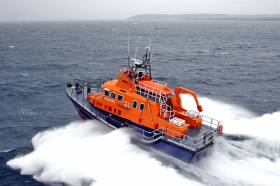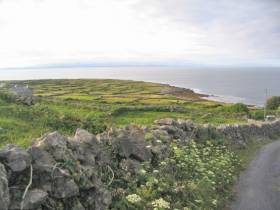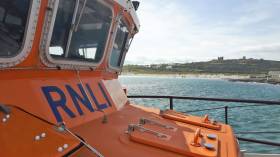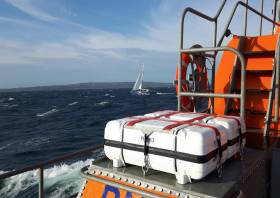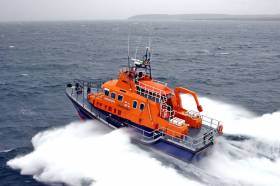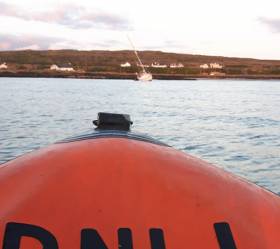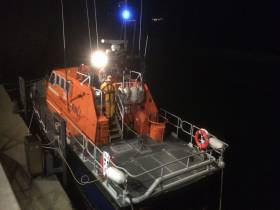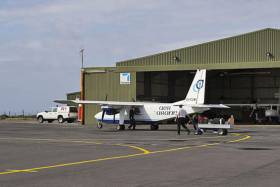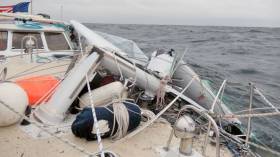Displaying items by tag: Aran Islands
Aran Islands Lifeboat Crew In Medevac Of Injured Tourist
Aran Islands lifeboat volunteers launched their all-weather lifeboat on Saturday afternoon (17 August) to carry out a medical evacuation for an injured tourist.
The female visitor to Inis Mór had sustained a suspected fractured leg while out sightseeing, Aran Islands RNLI said.
The casualty was transferred safely aboard the Severn class lifeboat David Kirkaldy under coxswain Tommy Dirrane and a full crew, and was brought to the waiting ambulance at Rossaveal Harbour.
Dirrane said later: “The volunteer crew members train regularly to maintain their quick response time and that can make all the difference to the casualty you are going to help. We would like to wish the casualty a speedy recovery.”
Elsewhere on Saturday, Rosslare Harbour RNLI volunteers were called to assist a small yacht with two onboard in difficulty off Cahore Point off the North Wexford coast.
Tangled in a lobster pot line and unable to sail in the freshening south westerly wind, the crew called the Irish Coast Guard for assistance, according to the RNLI.
Rosslare Harbour RNLI volunteers launched their all-weather lifeboat and reached the yacht in a short time.
Lifeboat volunteers reached the yacht in short order and set up a tow line to bring it close to Cahore Harbour, where the Cahore inshore rescue boat took over due to the shallow water.
Rosslare Harbour RNLI coxswain Eamonn O’Rourke said: “I would like to commend our volunteer crew who worked hard to attach a tow to the yacht in challenging conditions. We were glad to see the vulnerable yacht and her crew safe.”
Opportunities For Clean Energy In Ireland’s Island Communities
Island life, in all its challenges, also harbours opportunity for the transition to renewable energy — and the people of the Aran Islands are putting that into practice.
Juliette Gash reports for RTÉ Radio 1’s Morning Ireland from the Galway Bay island group, where the local energy co-operative set an ambitious target to be self-sustainable for energy generated from the wind, waves and sun by 2022.
While they may not hit 100% by that date, they have made progress that outs the rest of Ireland to shame.
But that should be no surprise when Ireland’s island communities have long been ahead of the curve when it comes to green energy — particularly Cape Clear in West Cork, which until 1993 had the world’s first integrated wind energy system.
Listen to the full RTÉ Morning Ireland report below:
Aran Islands RNLI responded to two medical evacuations, or medevacs, yesterday morning (Tuesday 23 July).
The all-weather Severn class lifeboat Margaret, Joan and Fred NYE launched at 10.15am following a request from the Irish Coast Guard, headed initially to Inis Meain.
Weather conditions were good with a 1.5m swell and a force 4-5 southerly wind as coxswain Mairtín O’Flaithearta and a full crew approached the pier at Inis Meain, where a teenager requiring further medical attention was taken aboard the lifeboat.
The crew then proceeded to Inis Oirr, where a young child also requiring further medical attention was taken aboard.
Both casualties were then taken straight to Rossaveal Harbour where they were transferred to hospital for further treatment.
Speaking after the callout, O’Flaithearta said: “A call can come at any time, and often like today where we had get two call outs at once. In situations like this, our regular crew training helps with a quick response time.
“We would like to wish both casualties a speedy recovery.”
The medevac came just days after Aran Islands RNLI were called to assist a yacht with engine difficulty off Straw Island.
Aran Islands RNLI rescued two sailors after their 38ft yacht got into difficulties off Gorumna Island in Co Galway yesterday morning (Thursday 27 June).
The station received the shout at 7.27am and the lifeboat David Kirkaldy launched under coxswain Tommy Dirrane with a full crew, heading straight for the 38ft yacht that had got tangled in lobster pots in the North Sound.
Conditions on the water were choppy with moderate seas and a 1.5m swell, and an east to north-easterly wind.
Once on scene, the lifeboat crew established contact with the two people aboard the yacht, and found that a local fisherman in the area had freed the vessel from the tangled lobster pots.
The lifeboat then escorted the yacht, which was under sail, as far as the mouth of Kilronan Harbour, where a tow line was established due to steering issues to guide the yacht alongside the pier.
Speaking after the callout, Dirrane said: “Thankfully, this was a good outcome to what could have been a different situation and we would like to commend the local fisherman who also helped.
“As we enjoy the good weather and the summer months ahead, we would like to remind anyone planning a trip to sea to always respect the water.”
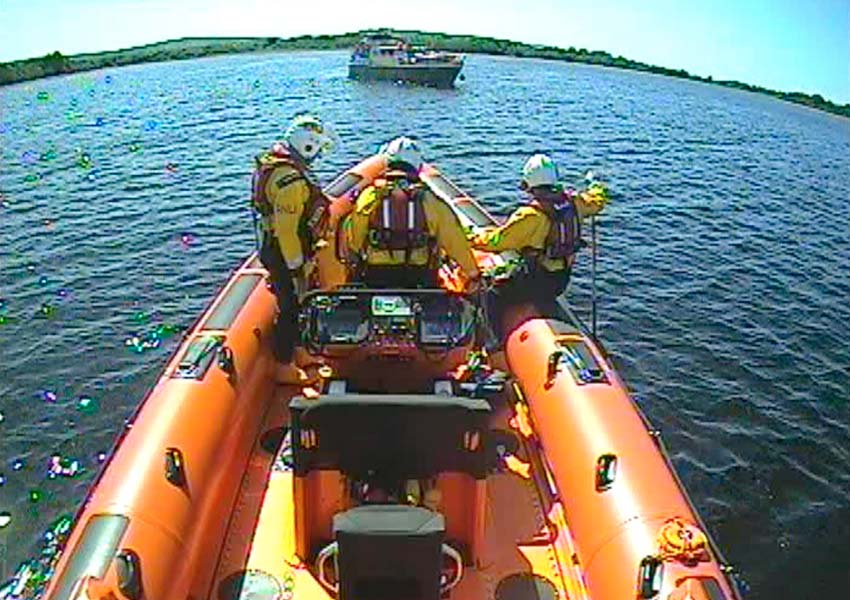 Carrybridge RNLI with the grounded vessel close to the Share Discovery Village | Photo: RNLI/Carrybridge
Carrybridge RNLI with the grounded vessel close to the Share Discovery Village | Photo: RNLI/Carrybridge
Elsewhere, Carrybridge RNLI launched its inshore lifeboat yesterday afternoon to aid a vessel with five on board that had run around around a mile north-west of the Share Discovery Village on Upper Lough Erne.
All on board were found safe and well, and wearing lifejackets. Their vessel was not taking on water, so a tow line was set up to refloat it in deeper water.
After checks for damage gave the all-clear, the vessel was allowed to continue its journey.
Lifeboat operations manager Stephen Scott added: “We would remind all users that before going afloat they should always carry a means of communication and to plan their voyage using relevant charts.
“If you see someone in trouble on the water or are in difficulties yourself the number to dial is: 999 or 112 and ask for the coastguard.”
Aran Islands RNLI’s volunteer lifeboat crew were tasked to launch their all-weather lifeboat early in the early hours of yesterday morning, Saturday 22 June.
A young man visiting Inis Mór had sustained an eye injury that required further medical attention.
The lifeboat launched after 2.30am in calm seas under coxswain Tommy Dirrane and with six crew members onboard, and after collecting the young man proceeded to Rossaveal Harbour.
The patient was then transferred safely to a waiting ambulance and on to University College Hospital Galway for further treatment.
Speaking following the callout, Dirrane said: “Our volunteers had an early morning wake-up call today but that it is what they are trained, willing and prepared to do to help anyone they can.
“All at Aran Islands RNLI would like to wish the casualty a speedy recovery.”
Aran Islands RNLI Responds Twice within hours To Assist Patient & Rescue a Lone Sailor
Aran Islands RNLI responded to two call-outs last night and early this morning to carry out a medical evacuation and come to the aid of a lone sailor.
The volunteer crew was first asked to launch their all-weather lifeboat at 11 pm on Monday night following a request from the Irish Coast Guard to transport a patient under medical advice to Rossaveal Harbour and on to a waiting ambulance.
The lifeboat under Coxswain John O’Donnell and with six crew members onboard, launched immediately and made their way to the scene to carry out the medical evacuation. Weather conditions at the time were good with calm waters.
Later in the early hours of this morning, the volunteer crew was requested to launch their lifeboat at 4.50am by the Irish Coast Guard following a report that a 38ft yacht with one sailor onboard had run aground in Kilronan Harbour after it's mooring line broke.
The lifeboat under Coxswain John O'Donnell launched once again and went to the aid of the yacht. Weather conditions at this time were good with calm seas.
Once on scene, the crew proceeded to launch the lifeboat’s small inflatable daughter boat which is used in rescues to access areas near rocks and shallow waters. The three crew members onboard this y-boat made their way to the stranded yacht where two crew members then boarded the yacht and first assessed that the sailor was safe and well before assisting him with the incoming tide to free his yacht from her grounding.
Speaking following the call out, Lena O’Connell, Aran Islands RNLI Lifeboat Press Officer said: ‘While our volunteers are always prepared for the pager to go off at any time, it is unusual to get back to back call outs in quick succession during the night. We would like to wish both the patient who required a medical evacuation off the island and the lone sailor all the best'.
Baltimore Lifeboat In Medical Evacuation From Sherkin Island
#Lifeboats - Baltimore RNLI carried out a medevac on Thursday night (11 April) from Sherkin Island off the coast of West Cork.
The volunteer crew launched their all-weather lifeboat following a request from the Irish Coast Guard at 9.29pm to provide medical assistance and evacuation to an islander living on Sherkin.
Conditions at sea during the callout were calm with good visibility and no sea swell.
The lifeboat arrived at Sherkin pier at 9.45pm, the casualty was brought onboard and the lifeboat departed the island within four minutes, handing the casualty over to the care of HSE ambulance crew at 10.08pm.
Speaking following the callout, Kate Callanan, Baltimore RNLI volunteer lifeboat press officer, said: “Baltimore RNLI regularly provides the vital service of medical evacuations (medevacs) for residents and visitors to local islands such as Sherkin, Cape Clear and Heir.
“If you find yourself in need of medical assistance, call 999 or 112 and ask for the coastguard.”
Elsewhere, volunteer lifeboat crews from the Aran Islands and Galway RNLI participated in a multi-agency training exercise on Galway Bay this week.
The all-weather lifeboat from Aran Islands RNLI and the inshore lifeboat from Galway Bay RNLI were among the many emergency service agencies that took part in a maritime mass rescue exercise.
The scenario training, which saw the lifeboat crew practise an evacuation of survivors from a seagoing ferry in a busy shipping lane, was organised as part of a multi-agency exercise co-ordinated by the Irish Coast Guard.
Among the other agencies involved were the Irish Coast Guard rescue helicopters located at Sligo and Shannon, Doolin/Inisheer Boat Unit, Costello Bay, Killaloe, Kilkee and Cleggan Coast Guard units, Galway Fire Service and the HSE.
New Short-Term Deal Struck For Aran Islands Air Service
#IslandNews - Air service between the Aran Islands and the mainland has been saved for two more weeks after a short-term tender was agreed, as The Irish Times reports.
Aer Arann Islands gave notice in June that it would terminate its PSO arrangement for the service this month two years ahead of schedule, citing contractual terms that affect its profitability.
The company’s owner even offered earlier this week to sell the airline to the islands’ communities for a nominal €1 sum.
Flights were expected to halt after next Thursday 6 December but a last-minute deal with the Department of Culture, Heritage and the Gaeltacht will see the service continue till at least Thursday 20 December.
The Irish Times has more on the story HERE.
Work Begins On Historic Rare Dublin Built Former Aran Islands Ferry to Become Luxury Liffey Hotel
#HistoricBoats - Afloat has noted work has recently begun in Dublin's Grand Canal Dockyard to transform a former CIÉ Aran Islands passenger /freight ferry as previously covered into a floating 5-star luxury hotel on the Liffey, writes Jehan Ashmore.
Commenting to Afloat, the owners Irish Ship & Barge Fabrication Co said the initial works are to clear the vessel of combustible materials in preparation for the €6.6m restoration project which is scheduled to be completed next year.
The first stage of the project will require work to survey the vessel's hull, but this can only be done with the ship removed out of the Grand Canal Dock basin's historic Georgian built graving dock of more than 200 years old. This is to facilitate the installation of docking blocks that will correctly position the ship's keel before any further works can take place.
Naomh Éanna was built for Córas Iompair Éireann (CIÉ) to serve the Galway-Aran Islands ferry route. For almost the last three decades, however the small passenger, freight and livestock carrier ship has languished in the Grand Canal Dock basin. The basin at Grand Canal Dock opened in 1796 which has three locks linking to the Liffey and were last in use by commerical ships until the 1960's.
In 2015 the IS&BFCo. for €1 acquired Naomh Éanna from the Irish Nautical Trust, as the vessel completed in 1958 is a rare surviving example of an Irish built ship (Liffey Dockyard) and constructed by rivetting. Then the practice was at the end of an era not just in Ireland but in Europe. Following the ferry's withdrawal from the Aran Islands service in 1988, the ship transferred from the state transport company to the ownership of the Trust. They intended to make the ship into a museum about the Aran service in addition to be in a seaworthy state.
Naomh Éanna's berth in the basin's Georgian graving docks in Ringsend is notable given the facility was disused (see save architecture). The IS&BFCo is working to restore the veteran vessel now in its 60th year in the drydock for a new career as a luxury hotel berthed on the capital's city centre quays.
Naomh Éanna's transformation is to involve a 28-cabin hotel complete with a glazed restaurant on the boat deck. The work follows Dublin City Council awarding a licence earlier this year, which permits the vessel to berth on Custom House Quay along the Liffey following a public tendering process. The waterbased process seeks to animate the river frontage lining the 'Docklands' quarter, the modern financial quarter downriver of O'Connell Street.
Roll back three decades when safety concerns from the Irish maritime authorities, chiefly stability, led to the withdrawal of the 483 tonnes Naomh Éanna from the Aran Islands service. The closure of the three-hour seasonal route on the Atlantic Ocean became the last passenger service directly linking the mainland mid-west city port and the trio of islands. A cargo-only service remains through a private operator, Lasta Mara Teo using the Bláth na Mara.
Up until recent years the former ferry in Grand Canal Dock was home to a watersports shop. The shop occupied the former cargohold, as shown in a rare photo overlooking the vessel's deck layout. On that occasion a visit involved having to access a quayside building for the purposes of a piece published in Ships Monthly, May 2014.
In that same year, the fate of Naomh Éanna could of been all so different, as the principle authority in charge of Grand Canal Dock, Waterways Ireland intended to dispose the vessel through scrapping having been alongside Charlotte Quay for decades. Other laid up and abandoned vessels, albeit smaller craft were also subject to a removal clearance programme as the area had become run down.
Fears that the old Aran Islands ferry cargoship would sink led Watersways Ireland to tow the vessel to the nearby Georgian built dry-dock, though this procedure required firstly a digger to widen the entrance to the dry dock. From within the drydock the ship was to have been scrapped.
A campaign was raised for Naomh Éanna, the Save Our Ship (SOS) group which was led by those concerned in assisting to secure the unique ship launched from the Liffey Dockyard. The shipbuilder no longer exists, though it was rathar apt to have observed the vessel occupy a berth a stone's throw of the shipyard site in Alexandra Basin. On that occasion the visit to the port took place in the year the former ferry returned to the capital in 1989.
Campaigners protests resulted in the Seanad, upper house of the Irish Parliament, to grant a reprieve given the vessel's historic Irish maritime heritage, despite a previous appeal rejected by the Department of Heritage.
An extended timeframe was made to allow efforts to concieve a restoration project, where the IS&BF originally proposed to return the Galway registered ship back to its western homeport. The Port of Galway was where the former ferry would become a floating boutique hostel, micro-brewery and museum recounting the Aran service. However, plans fell through resulting in Dublin retaining its own built ship.
Afloat's recent visit to Grand Canal Dock basin also noted waterbased commercial boat activity, albeit only applies to the regular traffic of Viking Splash Tours. Their amphibious excursion / tourist craft use the Grand Canal Dockyard's slip, exactly at this location is where the largest of the three Georgian graving docks had occupied but is now infilled.
#Rescue - A US yachtsman sings the praises of the RNLI and people of Inis Mór who took him in after his yacht dismasted at sea, according to The Irish Times.
John Lubimir and his wife Christine were sailing their yacht Patriot in the Aran Islands just weeks after circumnavigating Ireland when its carbon fibre mast snapped.
That was in spite of the moderate conditions — with a 12-14 knot southwesterly — and the mast being only 18 months old.
The damage wasn’t limited to the mast itself, as it gouged a hole in the top cabin of the Able Apogée 58 and threatened to hole the vessel’s hull.
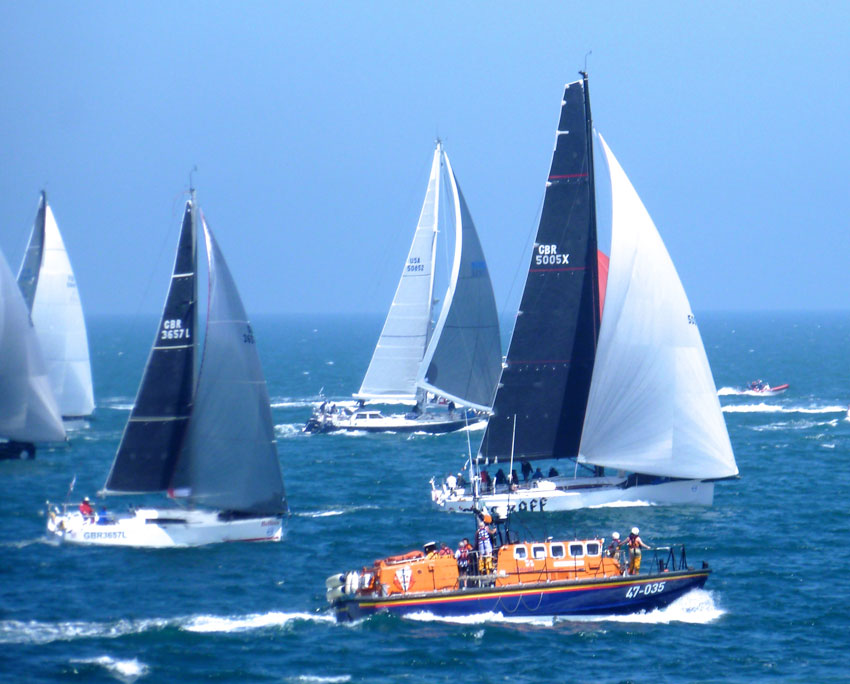 When the going was good: the 58ft Patriot (centre, dark hull) at the start of the Volvo Round Ireland race on 30 June. Patriot came second in its class in this year’s race Photo: W M Nixon
When the going was good: the 58ft Patriot (centre, dark hull) at the start of the Volvo Round Ireland race on 30 June. Patriot came second in its class in this year’s race Photo: W M Nixon
But after a call to the coastguard, Aran Islands RNLI were on the way to escort the Lubimirs to the safety of Inis Mór and avoid a “potentially tragic” situation, as John puts it.
And while John sorts out the insurance claim, he’s being treated to the Aran Islands’ legendary hospitality.
The Irish Times has more on the story HERE.


























